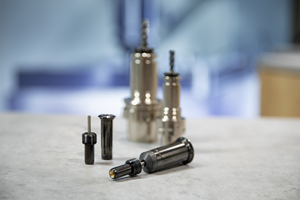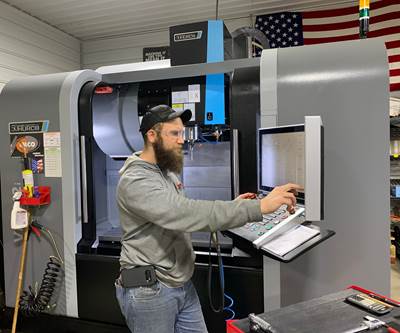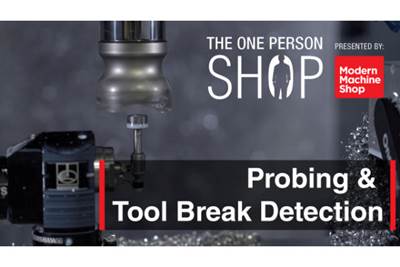How to Manage Cutting Tool Inventory in a Small Job Shop — The One-Person Shop #4
Working in short lead times means maintaining a large range of tools to be ready. What is the right way to stock and organize this investment?
Share




Let’s talk about all the tool inventory a small job shop might require. Because the shop has to be prepared to machine unexpected jobs both quickly and cost-effectively, it needs to keep a wide range of tools at the ready. That is, the right set of tools for whatever job might come along. The shop therefore could have an amount of money tied up in tool inventory that is equivalent to the cost of a piece of machinery.
How should the small, independent shop manage, maintain and organize this investment? Dan Donaworth of Dan’s Custom Machining discusses tool inventory in this episode of The One-Person Shop:
Transcript:
Peter Zelinski
Pete Zelinski, Modern Machine Shop. This video series is “The One Person Shop.” We are talking about all the different ways, techniques, products, strategies, that can let a very small shop be very competitive, very effective. We are at Dan's Custom Machining, Williamsburg, Ohio, and the owner of Dan's custom machining is Dan Donaworth. Dan, thank you for having us back.
Dan Donaworth
No problem, Pete. Thanks for coming out.
Peter Zelinski
What we're going to talk about with this episode is the cost that goes into a job shop, even a small job shop. You've probably never thought about this before, but it actually costs quite a bit to keep this place running. One of those costs is tool inventory. How much expense do you have wrapped up in cutting tools right now? Tools that are in the shop right now would you guess and another guess, how many varieties of different cutters do you have on hand?
Dan Donaworth
I'd say if you added up our cutting tool inventory for end mills and inserts for turning, we'd probably keep anywhere from fifteen to $17,000 on hand in the shop of different varieties. Out of that we probably keep in stock, probably over 100 different variety of end mills from sizes as small as 0.02, all the way up to three quarter inch end mill.
Peter Zelinski
And you need that inventory. You need it available and on hand. Why? Why is that so important?
Dan Donaworth
The biggest reason we needed available and on hand is, for us being a job shop, everyone needs their parts and they need it now. For us, being able to offer two weeks, three weeks turn time is very important and even in instances of what's changing in manufacturing where say tools are made elsewhere and need to come here when if they can't get the tools here because of some worldwide event. We already have it on hand, we can still keep going with what's here and we keep extras.
Peter Zelinski
Is there a situation, an anecdote, that comes to mind when you did not have a tool that you really needed? Can you tell that story?
Dan Donaworth
When I was machining a part, I thought I had everything ordered. Went to go start the part, part was due the Monday we were going into a Friday part was do that next coming Monday, didn't have the long reach end mill that I needed to reach down in there and I ended up having to improvise I did work around to get through it. But life was not fun for that weekend trying to get the job done and that was just one more tool that now we keep in stock and have for those odd reach positions.
Peter Zelinski
You describe the large quantity, large variety of tools you have on hand. How do you know what tools to keep? What kind of thinking went into determining what tools you need to have on hand?
Dan Donaworth
Pretty much we have our CAM library is all up to date and accurate with all the tools that we have in our drawer over at the machine and each door at the machine has a label on it, which tells you what end mill it is. We try to keep four of everything in stock and our drawer, three of the stuff that's not as common, and pretty much once we relate an establishment with a customer, and we know the style of parts that they do any tool that they would ever need or use we keep in stock.
Peter Zelinski
Any tool they might need you keep in stock, you keep three or four of different tooling items apiece on hand. What is your system? How do you keep all of that inventory stock? When you use tools? Like what is what is reordering look like? What is your system look like for maintaining that inventory?
Dan Donaworth
The way I go through it is once a week I tried to sit down and order tools that I would need to reorder when I take an end mill out, if it's down to the reorder amount, which I will take the empty cartridge and I'll put it on my desk. And that's how at the end of the week I know to reorder that tool and at the beginning of every week I go through and make sure I didn't miss everything and count the drawers.
Peter Zelinski
Do you have one tooling supplier or a variety?
Dan Donaworth
Typically on the mills we have one tooling supplier that we use, it just makes it easier for us to keep track. And with their being a local company, we can have tools usually next day if they're in stock . So we pick our tooling vendors based on accessibility and service and support. And as far as inserts go, we do use a little bit of variety as far as insert cutters.
Peter Zelinski
Related question: We've been talking about tooling in terms of the actual cutters themselves. Using those mills effectively also involves a toolholder investment. How do you use hydraulic toolholders?
Dan Donaworth
We use hydraulic toolholders for all our accurate run-out holding of micro end mills. We use it for our large toolholding, too, for three quarter inch end mills just to allow the most accurate run-out that we can to do adaptive toolpaths and really hammer at the material and remove it as fast as possible.
Peter Zelinski
Thoughts about cutting tools, about maintaining a job shop’s cutting tool inventory. Check out more videos in this series, our our video series on the one person shop. Dan, thank you again for having us.
Dan Donaworth
No problem.
Related Content
Rego-Fix Toolholding System Reduces Coolant Consumption
MQL PG collets are designed for machines using one-channel, internal through-spindle MQL systems.
Read MoreRego-Fix’s Center for Machining Excellence Promotes Collaboration
The new space includes a showroom, office spaces and an auditorium that will enhance its work with its technical partners.
Read MoreQuick-Change Tool Heads Reduce Setup on Swiss-Type Turning Centers
This new quick-change tooling system enables shops to get more production from their Swiss turning centers through reduced tool setup time and matches the performance of a solid tool.
Read MoreThrough-Coolant System Cuts Nickel-Alloy Cycle Times by 70%
Decker Machine Works recently adopted Rego-Fix’s reCool through-coolant system for ER collets, reducing the cycle times on a nickel alloy job by 70%.
Read MoreRead Next
5 Hard Lessons from a 28-Year-Old Startup Machine Shop Owner
Good fortune and years of long working hours have both figured into the success of this young shop, which became its founder’s sole employment starting last year. The shop owner shares his story.
Read MoreVacuum Workholding for Thin Parts: First Episode of The One-Person Shop
A new video series looks at technology and practices for thriving as a very small machining business. In this episode, how workholding using air pressure permits rapid setup of parts too delicate to be held in a vise.
Read MoreProbing for Setup and Lights-Out Machining — The One-Person Shop Episode #2
Automatic measurement on the machine tool speeds efficiency by day and safeguards capacity at night for a small machine shop.
Read More


















.png;maxWidth=300;quality=90)












